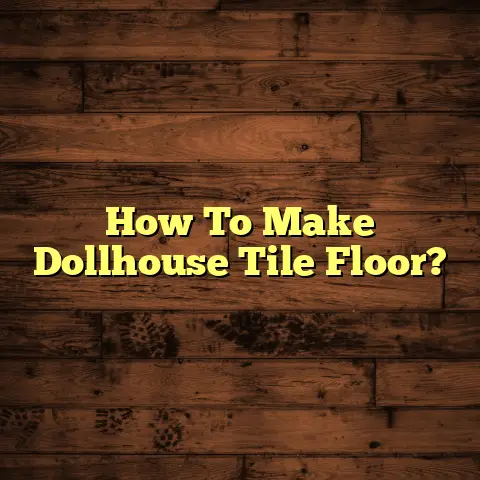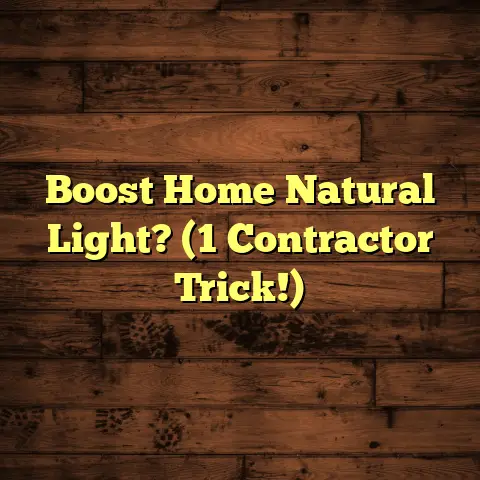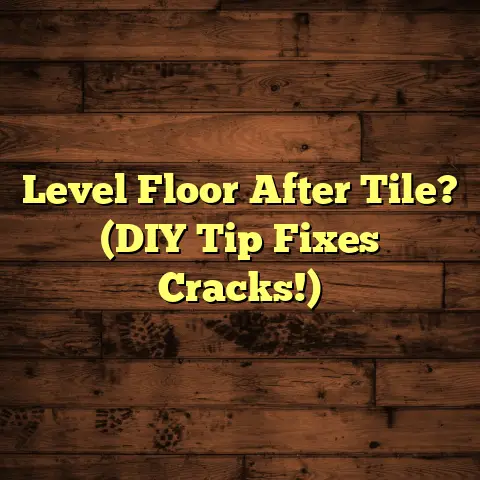Vinyl Plank: A Floating Floor? (5 Install Tips)
In a world where every step we take reverberates through the ground beneath us, the choice of flooring becomes not just a matter of aesthetics, but a dramatic statement of comfort, durability, and style.
Imagine walking across a surface that not only transforms your living space but also whispers tales of resilience and innovation.
Enter vinyl plank flooring—a revolutionary leap in home design that promises to redefine our connection to the very ground we walk on. But with its allure comes a crucial question: Is vinyl plank truly a floating floor?
In this exploration, I’ll share my expertise as a flooring contractor, delving into the essence of vinyl plank flooring, unraveling the secrets behind its installation while equipping you with five essential tips to ensure your project is nothing short of spectacular.
Introduction
Flooring, right? It’s more than just what you walk on. It sets the tone for your entire home. Think about it: the color, the texture, the way it feels underfoot – it all contributes to the overall vibe.
And let’s be honest, nobody wants outdated, worn-out floors dragging down their design.
That’s where vinyl plank flooring comes in. It’s become a total game-changer. It offers a modern solution to so many of the issues that plague traditional flooring options.
We’re talking about durability, style, and even ease of installation. But here’s the million-dollar question: Is vinyl plank really a floating floor?
That’s what we’re going to unpack today. We’ll dive deep into what that actually means and how you can make it work flawlessly in your own home.
Section 1: Understanding Vinyl Plank Flooring
Let’s get down to the nitty-gritty of what vinyl plank flooring actually is. It’s essentially a multi-layered synthetic flooring product designed to mimic the look of natural materials like wood or stone.
But don’t let the “synthetic” part fool you. Modern vinyl plank is miles away from the cheap, flimsy vinyl of yesteryear.
It’s constructed with several layers, including a wear layer (that tough top coat that protects against scratches and stains), a decorative layer (that gives it the realistic wood or stone look), and a core layer (which provides stability and water resistance).
Advantages Over Traditional Flooring
Why is vinyl plank flooring such a hot topic these days? Well, it boasts some serious advantages over traditional options like hardwood, tile, and carpet:
-
Durability: Vinyl plank is incredibly durable. It can withstand heavy foot traffic, spills, and even pets without showing significant wear and tear.
-
Water Resistance: Unlike hardwood, vinyl plank is highly water-resistant, making it a fantastic choice for bathrooms, kitchens, and basements.
-
Ease of Maintenance: Forget about special cleaners or complicated routines. Vinyl plank is easy to clean with just a damp mop and mild detergent.
-
Cost-Effectiveness: Compared to hardwood or tile, vinyl plank is significantly more affordable, both in terms of materials and installation costs.
-
DIY-Friendliness: Many vinyl plank products are designed for easy installation, making them a great option for DIY enthusiasts.
Versatility in Various Settings
One of the things I love most about vinyl plank is its versatility. It’s equally at home in residential and commercial settings.
I’ve installed it in everything from cozy living rooms to bustling office spaces. Its ability to withstand heavy use and resist moisture makes it a practical choice for virtually any environment.
Different Types of Vinyl Plank
Okay, let’s talk about the different types of vinyl plank you’ll encounter:
-
Luxury Vinyl Plank (LVP): This is the premium stuff. It’s thicker, more durable, and often features enhanced realistic visuals and textures. If you want the best of the best, LVP is the way to go.
-
Rigid Core Vinyl Plank: This type has a super-stiff core, making it incredibly stable and resistant to dents and indentations. It’s a great choice for high-traffic areas or homes with kids and pets.
-
Waterproof Vinyl Plank: As the name suggests, this type is completely waterproof. It’s ideal for bathrooms, kitchens, or any area prone to moisture.
Fun Fact: Did you know that the global vinyl flooring market is projected to reach over \$40 billion by 2027? Source: Grand View Research
That just goes to show how popular and versatile this flooring option has become!
Section 2: What Makes a Floor “Floating”?
Alright, let’s get to the heart of the matter: what exactly is a floating floor?
In simple terms, a floating floor is a flooring system that isn’t directly attached to the subfloor beneath it.
Instead, the planks or tiles interlock with each other, forming a single, continuous surface that “floats” above the subfloor.
Think of it like a giant puzzle where the pieces fit together snugly but aren’t glued or nailed down.
Floating vs. Other Installation Methods
Traditional flooring installation methods involve directly attaching the flooring to the subfloor using adhesives (glued down) or fasteners (nailed).
Floating floors, on the other hand, rely on the interlocking mechanism and the weight of the flooring itself to stay in place.
This has some pretty significant implications:
-
Glued Down: This method provides a very stable and permanent installation, but it’s also more labor-intensive and difficult to remove later.
-
Nailed: Typically used for hardwood flooring, nailing provides a secure attachment but requires specialized tools and expertise.
-
Floating: This method is generally easier and faster to install, making it a popular choice for DIY projects. It also allows for some movement and expansion/contraction, which can be beneficial in certain environments.
Does Vinyl Plank Qualify?
So, does vinyl plank flooring qualify as a floating floor? In most cases, the answer is a resounding yes! The majority of vinyl plank products are designed with a tongue-and-groove or click-lock system that allows them to be installed as a floating floor.
This means you don’t need to mess with messy adhesives or noisy nail guns. You simply click the planks together, and they form a secure, floating surface.
Implications of Floating
The fact that vinyl plank can be installed as a floating floor has some pretty significant implications:
-
Easier Installation: As I mentioned earlier, floating floors are generally easier to install than glued-down or nailed-down options. This makes them a great choice for DIYers.
-
Subfloor Flexibility: Floating floors are more forgiving when it comes to subfloor imperfections. They can often be installed over slightly uneven or imperfect subfloors without issue.
-
Expansion and Contraction: Floating floors allow for some natural expansion and contraction due to temperature and humidity changes. This can help prevent buckling or warping.
Section 3: The Benefits of Installing Vinyl Plank as a Floating Floor
Okay, so we know that vinyl plank can be installed as a floating floor. But why would you want to? What are the actual benefits of going this route?
Let’s break it down:
-
Ease of Installation: This is a big one. Floating vinyl plank is incredibly easy to install, even for beginners. The click-lock systems are designed to be intuitive and user-friendly, allowing you to transform your space in a matter of hours.
-
Moisture Resistance: Because the planks aren’t directly attached to the subfloor, floating vinyl plank is less susceptible to moisture damage. If water does seep through the seams, it’s less likely to get trapped and cause mold or mildew growth.
-
Cost-Effectiveness: Not only is the material itself relatively affordable, but the easy installation can save you a ton of money on professional labor costs.
-
Subfloor Integrity: Floating floors don’t require you to damage or alter the subfloor in any way. This can be a huge advantage if you’re working with an older home or a delicate subfloor.
-
Installation Over Existing Floors: In many cases, you can install floating vinyl plank directly over existing floors, such as tile, linoleum, or even concrete. This can save you a ton of time and effort on demolition and subfloor preparation.
-
Comfort and Sound Insulation: Many vinyl plank products come with a built-in underlayment or can be paired with a separate underlayment to provide added comfort and sound insulation. This can make your floors feel softer underfoot and reduce noise transmission between rooms.
Personal Story: I once had a client who was renovating their basement. They had ugly, cracked concrete floors that they wanted to cover up. We installed a floating vinyl plank floor directly over the concrete, and the transformation was amazing.
Not only did it look great, but it also made the basement feel warmer and more comfortable. Plus, they saved a ton of money by avoiding the cost of leveling and repairing the concrete subfloor.
Section 4: 5 Essential Installation Tips for Vinyl Plank Flooring
Alright, you’re convinced. Floating vinyl plank is the way to go. But before you start clicking those planks together, let’s go over some essential installation tips to ensure a flawless finish.
Tip #1: Preparation is Key
I cannot stress this enough: proper preparation is absolutely crucial for a successful vinyl plank installation. This means taking the time to:
-
Acclimate the Planks: Before you even think about installing, let the planks acclimate to the room’s temperature and humidity for at least 48-72 hours. This will help prevent expansion and contraction issues later on.
-
Prepare the Subfloor: Make sure the subfloor is clean, level, and dry. Remove any debris, fill in any cracks or holes, and ensure that it’s free of moisture. If the subfloor is uneven, you may need to use a self-leveling compound to create a smooth, even surface.
Tip #2: Choose the Right Underlayment
Underlayment is a thin layer of material that goes between the subfloor and the vinyl plank flooring. It plays a crucial role in floating floor systems by:
-
Providing Cushioning: Underlayment adds a layer of cushioning that makes the floors feel softer underfoot.
-
Reducing Noise: It helps to absorb sound and reduce noise transmission between rooms.
-
Providing Moisture Barrier: Some underlayments have a built-in moisture barrier that protects the flooring from moisture damage.
When choosing an underlayment, consider your specific needs:
-
Noise Reduction: If you live in an apartment or have kids who like to run around, choose an underlayment with a high sound transmission class (STC) rating.
-
Moisture Barrier: If you’re installing vinyl plank in a bathroom, kitchen, or basement, opt for an underlayment with a built-in moisture barrier.
-
Thickness: The thickness of the underlayment can affect the overall feel of the floor. Thicker underlayments generally provide more cushioning and sound insulation.
Tip #3: Plan Your Layout Wisely
Before you start clicking planks together, take some time to plan your layout. This will help you minimize waste, ensure a visually appealing finish, and avoid any awkward cuts or seams.
-
Measure the Room: Start by accurately measuring the room’s length and width.
-
Calculate the Number of Planks: Use these measurements to calculate the number of planks you’ll need to cover the entire floor.
-
Stagger the Seams: To create a more natural and visually appealing look, stagger the seams between rows of planks. Avoid creating a “stair-step” pattern, where the seams line up perfectly in each row.
-
Consider the Direction: Think about the direction in which you want to lay the planks. Running them parallel to the longest wall can make the room feel larger.
Tip #4: Leave Room for Expansion
Why is this so important? Because vinyl plank flooring, like most materials, will expand and contract slightly with temperature and humidity changes. If you don’t leave room for this expansion, the flooring can buckle or warp over time.
Use spacers to maintain a consistent expansion gap as you install the flooring. Once the installation is complete, you can cover the gap with baseboards or trim.
Tip #5: Finishing Touches
Once you’ve installed all the planks, it’s time for the finishing touches. This includes:
-
Installing Trim and Molding: Install baseboards, quarter-round molding, or other trim to cover the expansion gap and give the room a polished look.
-
Cleaning the Floor: Use a damp mop and mild detergent to clean the floor and remove any dust or debris.
-
Protecting the Floor: Place felt pads under furniture legs to prevent scratches and dents.
Pro Tip: Consider using a floor roller after installation to ensure proper adhesion and remove any air pockets.
Conclusion
So, there you have it! Vinyl plank flooring is a fantastic option for homeowners seeking a modern, stylish, and practical floating floor solution.
It’s durable, water-resistant, easy to install, and relatively affordable. Plus, with the right preparation and installation techniques, you can achieve a flawless finish that will transform your space.
I hope this article has empowered you to make informed decisions about your flooring choices and given you the confidence to tackle your own vinyl plank installation project.
Remember, flooring is more than just what you walk on. It’s an expression of your personal style and a foundation for your daily life. Choose wisely, install carefully, and enjoy the beauty and durability of your new vinyl plank floors!





